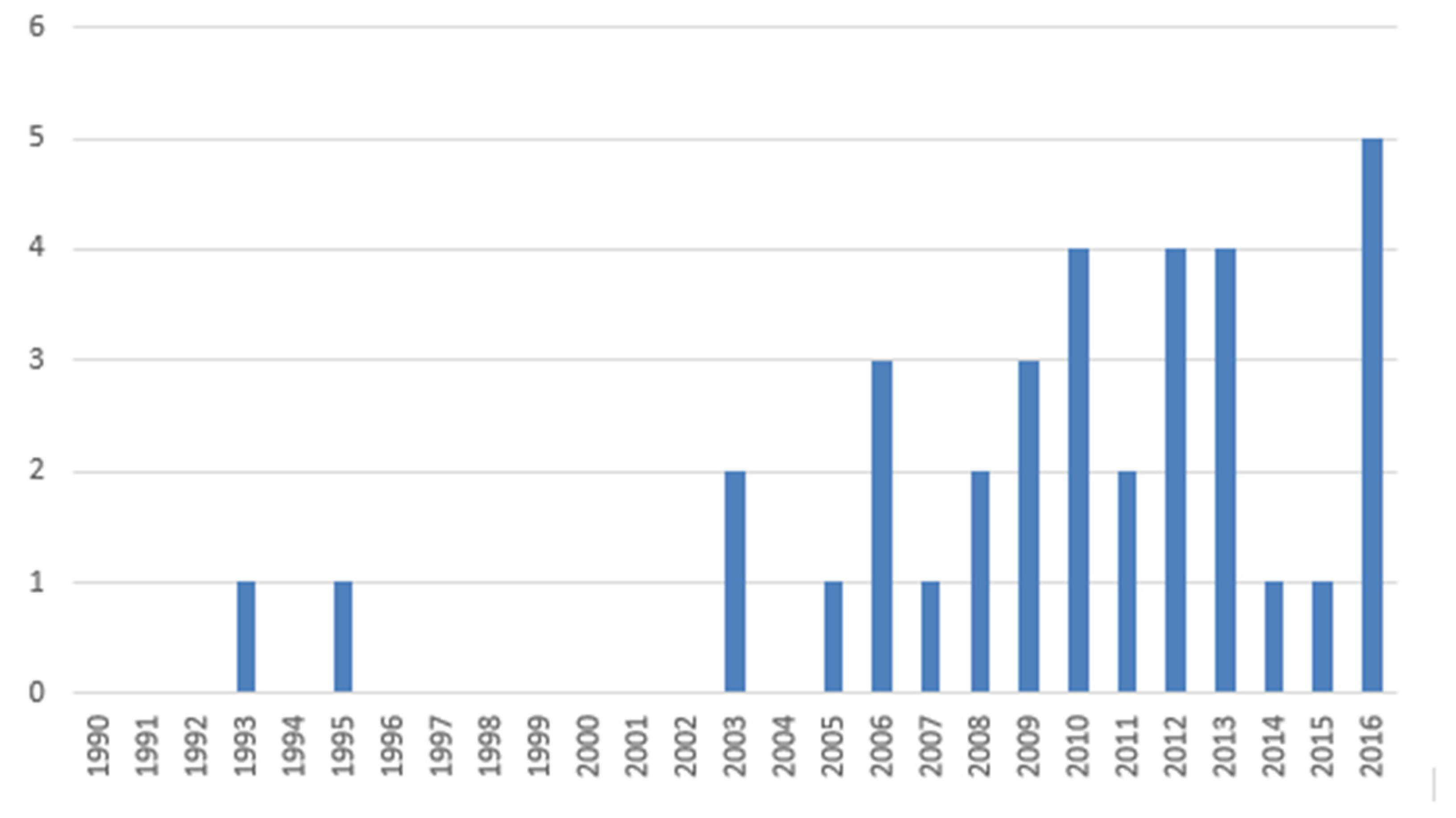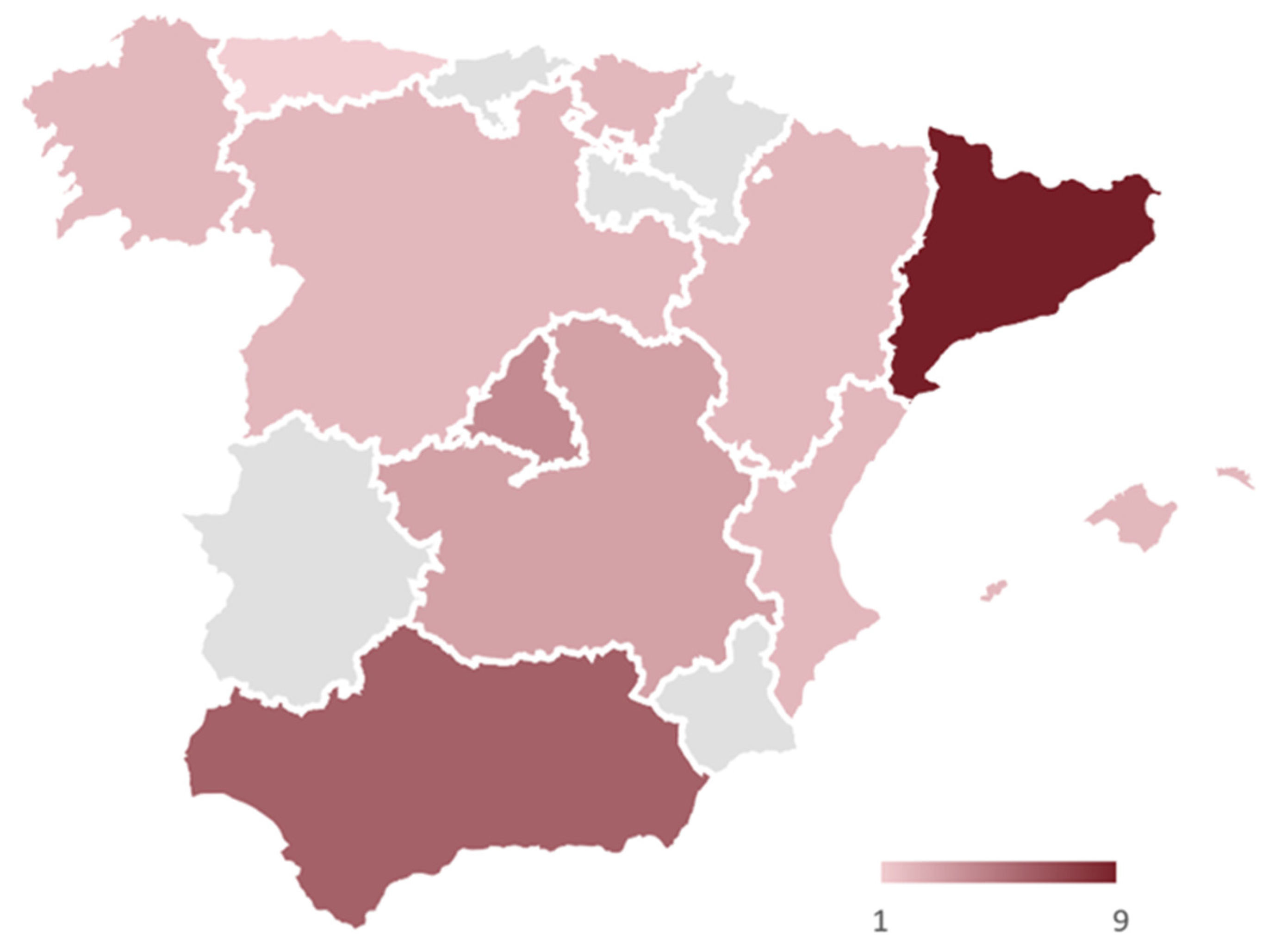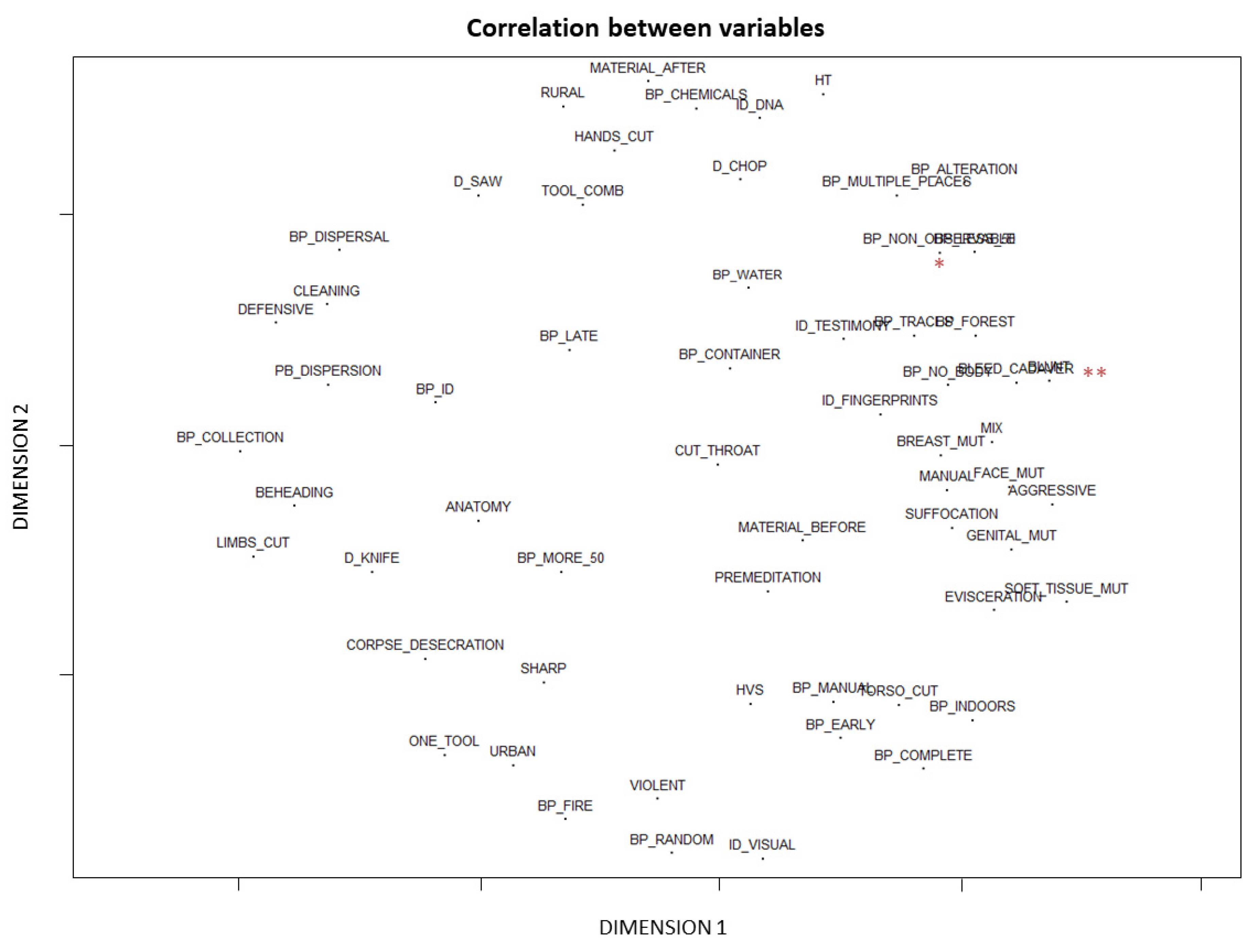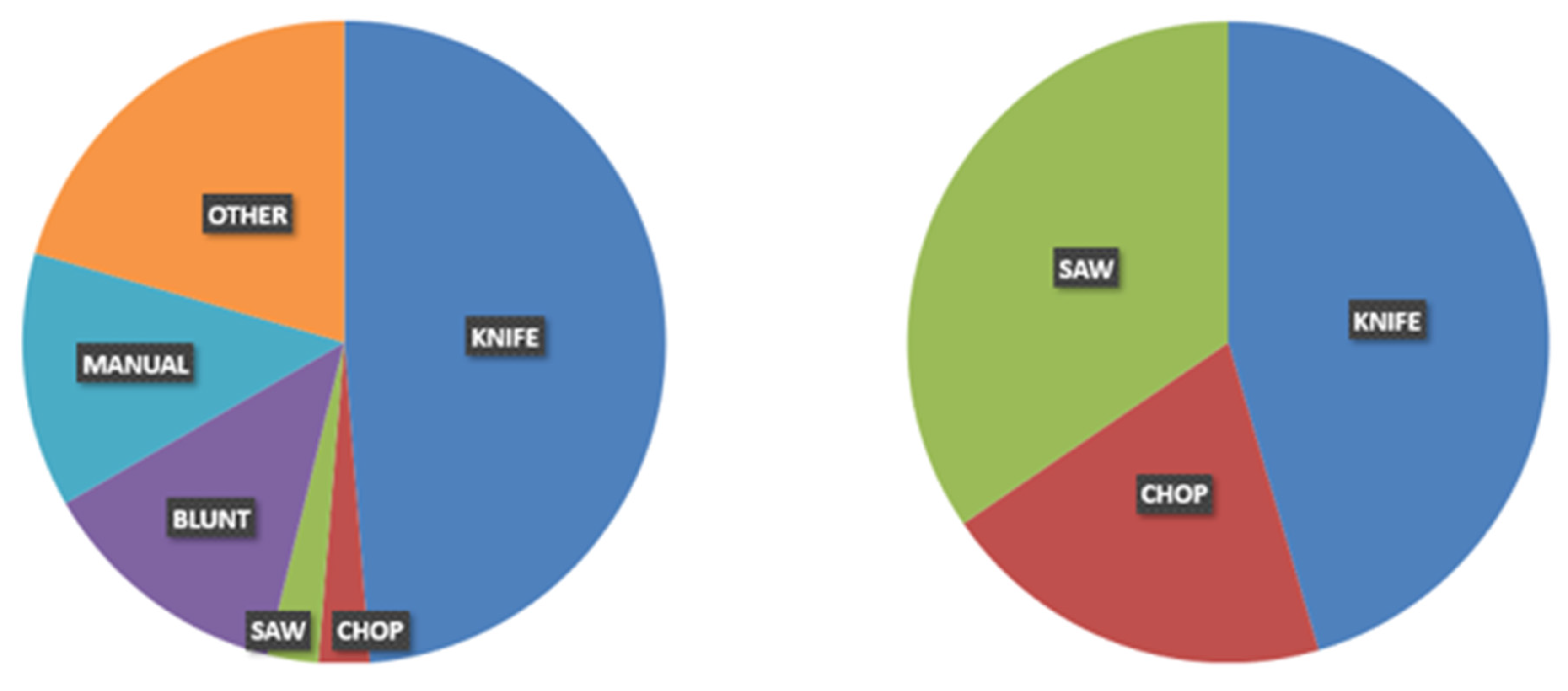Dismemberment as a Method of Body Disposal in Spanish Forensic Cases
Abstract
:1. Introduction
2. Materials and Methods
2.1. Database
- A total of 11 variables regarding the post-dismemberment alteration of the body as employed by Sea and Beauregard [39];
- A total of 13 variables regarding the crime organisation and planning, described in the study undertaken by Petreca et al. [16];
- A total of 17 variables regarding the state of preservation of the body and the medicolegal investigation obtained from the court records, following the definitions found in Byers [49] and the retrospective study made by Konopka et al. [2]. The dismemberment type was assessed following the definitions proposed by Black et al. [20].
2.2. Statistical Analysis
3. Results
3.1. Descriptive Analysis
3.2. Multidimensional Scaling
4. Discussion
4.1. Ratio of Dismemberment Cases
4.2. Victim and Offender Data
4.3. Cause and Manner of Death
4.4. Dismemberment
4.5. Post-Dismemberment Alteration
4.6. Organisation
4.7. Forensic Investigation
5. Conclusions
Author Contributions
Funding
Institutional Review Board Statement
Informed Consent Statement
Data Availability Statement
Acknowledgments
Conflicts of Interest
References
- Ross, A.H.; Humphries, A.; Cunha, E. The Pattern of Violence and Aggression. In Dismemberments; Elsevier: Amsterdam, The Netherlands, 2019; pp. 183–194. [Google Scholar]
- Konopka, T.; Strona, M.; Bolechała, F.; Kunz, J. Corpse dismemberment in the material collected by the Department of Forensic Medicine, Cracow, Poland. Leg. Med. 2017, 9, 1–13. [Google Scholar] [CrossRef] [PubMed]
- Ubelaker, D.H. The forensic evaluation of burned skeletal remains: A synthesis. Forensic Sci. Int. 2009, 183, 1–5. [Google Scholar] [CrossRef] [PubMed]
- Mayne Correia, P. Fire Modification of Bone. In Forensic Taphonomy; Haglund, W.D., Sorg, M.H., Eds.; CRC Press: Boca Raton, FL, USA, 1996; pp. 275–293. [Google Scholar]
- Di Nunno, N.; Costantinides, F.; Vacca, M.; Di Nunno, C. Dismemberment. Am. J. Forensic Med. Pathol. 2006, 27, 307–312. [Google Scholar] [CrossRef] [PubMed]
- Morcillo-Méndez, M.D.; Campos, I.Y. Dismemberment: Cause of death in the Colombian armed conflict. Torture Q. J. Rehabil. Torture Vict. Prev. Torture 2012, 22, 5–13. [Google Scholar]
- Pachar Lucio, J.V. Postmortem Criminal Mutilation in Panama. In Dismemberments; Elsevier: Amsterdam, The Netherlands, 2019; pp. 63–68. [Google Scholar]
- Sanabria-Medina, C.; Restrepo, H.O. Dismemberment of Victims in Colombia. In Dismemberments; Elsevier: Amsterdam, The Netherlands, 2019; pp. 7–41. [Google Scholar]
- Vásquez Guarín, C.; García Ospina, J.; Molina Castaño, C.F. Factores asociados a la identificación de cuerpos descuartizados o desmembrados en Medellín (Colombia). Rev. Española Med. Leg. 2021, 47, 9–15. [Google Scholar] [CrossRef]
- Dogan, K.H.; Demirci, S.; Deniz, I.; Erkol, Z. Decapitation and Dismemberment of the Corpse: A Matricide Case. J. Forensic Sci. 2010, 55, 542–545. [Google Scholar] [CrossRef]
- Symes, S.A.; Williams, J.A.; Murray, E.A.; Hoffman, J.M.; Holland, T.D.; Saul, J.M.; Saul, F.P.; Pope, E.J. Taphonomic Context of Sharp-Force Trauma in Suspected Cases of Human Mutilation and Dismemberment. In Advances in Forensic Taphonomy; Haglund, W.D., Sorg, M.H., Eds.; CRC Press: Boca Raton, FL, USA, 2001; pp. 403–434. [Google Scholar]
- Porta, D.; Amadasi, A.; Cappella, A.; Mazzarelli, D.; Magli, F.; Gibelli, D.; Rizzi, A.; Picozzi, M.; Gentilomo, A.; Cattaneo, C. Dismemberment and disarticulation: A forensic anthropological approach. J. Forensic Leg. Med. 2016, 38, 50–57. [Google Scholar] [CrossRef]
- Black, S.; Rutty, G.; Hainsworth, S.; Thomson, G. Criminal Dismemberment, 1st ed.; CRC Press: Boca Raton, FL, USA, 2017. [Google Scholar]
- Campobasso, C.P.; Dell’Erba, A.S.; Belviso, M.; Di Vella, G. Craniofacial Identification by Comparison of Antemortem and Postmortem Radiographs. Am. J. Forensic Med. Pathol. 2007, 28, 182–186. [Google Scholar] [CrossRef]
- Tidrick, M.; Brucato, G.; Petreca, V.; Burgess, A.W.; Stone, M.H. The insanity defense in cases of homicide involving post-mortem dismemberment. Forensic Sci. Int. Mind Law 2020, 1, 100033. [Google Scholar] [CrossRef]
- Petreca, V.G.; Burgess, A.W.; Stone, M.H.; Brucato, G. Dismemberment and Mutilation: A Data-Driven Exploration of Patterns, Motives, and Styles. J. Forensic Sci. 2020, 65, 888–896. [Google Scholar] [CrossRef]
- Adams, B.J.; Rainwater, C.W.; Yim, A.; Alesbury, H.S. A Retrospective Study of Intentional Body Dismemberment in New York City: 1996–2017. J. Forensic Sci. 2019, 64, 1012–1016. [Google Scholar] [CrossRef] [PubMed]
- Reichs, K.J. Postmortem dismemberment: Recovery, analysis and interpretation. In Forensic Osteology: Advances in the Identification of Human Remains; Reichs, K.J., Ed.; Charles C. Thomas: Springfield, IL, USA, 1998; pp. 353–388. [Google Scholar]
- Rainwater, C.W. Three modes of dismemberment: Disarticulation around the joints, transection of bone via chopping, and transection of bone via sawing. In Skeletal Trauma Analysis; John Wiley & Sons, Ltd.: Chichester, UK, 2015; pp. 222–245. [Google Scholar]
- Black, S.; Rutty, G.; Hainsworth, S.; Thomson, G. Introduction to criminal human dismemberment. In Criminal Dismemberments, 1st ed.; Black, S., Rutty, G., Hainsworth, S., Thomson, G., Eds.; CRC Press: Boca Raton, FL, USA, 2017; pp. 1–6. [Google Scholar]
- Cunha, E.; Hale, A.R.; Ross, A.H. Criminal Dismemberments. In Dismemberments; Elsevier: Amsterdam, The Netherlands, 2019; pp. 1–6. [Google Scholar]
- Almond, L.; Pell, C.; McManus, M. Body Part Removal: A Thematic Exploration of U.K. Homicide Offenses. J. Interpers. Violence 2018, 36, NP6370–NP6389. [Google Scholar] [CrossRef] [PubMed]
- Wilke-Schalhorst, N.; Schröder, A.S.; Püschel, K.; Edler, C. Criminal corpse dismemberment in Hamburg, Germany from 1959 to 2016. Forensic Sci. Int. 2019, 300, 145–150. [Google Scholar] [CrossRef]
- Püschel, K.; Koops, E. Dismemberment and mutilation. Arch. Für Kriminol. 1987, 180, 88–100. [Google Scholar]
- Häkkänen-Nyholm, H.; Weizmann-Henelius, G.; Salenius, S.; Lindberg, N.; Repo-Tiihonen, E. Homicides with Mutilation of the Victim’s Body. J. Forensic Sci. 2009, 54, 933–937. [Google Scholar] [CrossRef] [PubMed]
- Mata Tutor, P.; Villoria Rojas, C. Vayamos por partes—Desmembramiento y mutilación en España en los últimos 10 años. Anu. Int. De Criminol. Y Cienc. Forenses 2020, 5, 165–185. [Google Scholar]
- Keppel, R.D.; Weis, J.G.; Brown, K.M.; Welch, K. The Jack the Ripper murders: A modus operandi and signature analysis of the 1888–1891 Whitechapel murders. J. Investig. Psychol. Offender Profiling 2005, 2, 1–21. [Google Scholar] [CrossRef]
- Petreca, V.G.; Brucato, G.; Burgess, A.W.; Dixon, E. Criminal cannibalism: An examination of patterns and styles. Aggress. Violent Behav. 2020, 56, 101531. [Google Scholar] [CrossRef]
- Mata Tutor, P.; Villoria Rojas, C. La huella de Jack el Destripador: Dos casos de desmembramiento criminal necromaníaco en España. Quad. De Criminología. 2021, 51, 16–20. [Google Scholar]
- Duhig, C.; Martinsen, N. Many layers of taphonomy: Dismemberment and other body processing. In Forensic Anthropology: Case Studies from Europe, 1st ed.; Brickley, M., Ferllini, R., Eds.; Charles C. Thomas: Springfield, IL, USA, 2007; pp. 86–99. [Google Scholar]
- Sauer, N.J.; Simson, L.R. Clarifying the Role of Forensic Anthropologists in Death Investigations. J. Forensic Sci. 1984, 29, 11774J. [Google Scholar] [CrossRef]
- Mann, R.W.; Bass, W.M.; Meadows, L. Time Since Death and Decomposition of the Human Body: Variables and Observations in Case and Experimental Field Studies. J. Forensic Sci. 1990, 35, 12806J. [Google Scholar] [CrossRef] [Green Version]
- Smith, A.C. The Effects of Sharp-Force Thoracic Trauma on the Rate and Pattern of Decomposition. J. Forensic Sci. 2014, 59, 319–326. [Google Scholar] [CrossRef] [PubMed]
- Baigent, C.; Agan, C.; Connor, M.; Hansen, E.S. Autopsy as a form of evisceration: Implications for decomposition rate, pattern, and estimation of postmortem interval. Forensic Sci. Int. 2020, 306, 110068. [Google Scholar] [CrossRef] [PubMed]
- Heaton, V.; Lagden, A.; Moffatt, C.; Simmons, T. Predicting the Postmortem Submersion Interval for Human Remains Recovered from U.K. Waterways. J. Forensic Sci. 2010, 55, 302–307. [Google Scholar] [CrossRef]
- Byers, S.N. Estimating Postmortem Interval. In Introduction to Forensic Anthropology, 4th ed.; Byers, S.N., Ed.; Taylor & Francis: Abingdon, UK, 2016; pp. 109–129. [Google Scholar]
- Roberts, J.; Baldry, A. Disposal of a homicide victim by dismemberment and burning: The contribution of forensic anthropology and archaeology in reconstructing the crime. Archaeol. Environ. Forensic Sci. 2018, 2, 39–48. [Google Scholar] [CrossRef]
- De Matteis, M.; Giorgetti, A.; Viel, G.; Giraudo, C.; Terranova, C.; Lupi, A.; Fais, P.; Puggioni, A.; Cecchetto, G.; Montisci, M. Homicide and concealment of the corpse. Autopsy case series and review of the literature. Int. J. Leg. Med. 2020, 135, 1115. [Google Scholar] [CrossRef]
- Sea, J.; Beauregard, E. Mutilation in Korean Homicide: An Exploratory Study. J. Interpers. Violence 2019, 34, 2863–2877. [Google Scholar] [CrossRef]
- Mata Tutor, P.; Márquez-Grant, N.; Villoria Rojas, C.; García, A.M.; Pérez Guzmán, I.; Benito Sánchez, M. Through fire and flames: Post-burning survival and detection of dismemberment-related toolmarks in cremated cadavers. Int. J. Leg. Med. 2021, 135, 801–815. [Google Scholar] [CrossRef]
- Schmidt, C.W.; Symes, S.A. The Analysis of Burned Human Remains; Academic Press: Cambridge, MA, USA, 2015. [Google Scholar]
- Fairgrieve, S.I. Forensic Cremation: Recovery and Analysis; CRC Press: Boca Raton, FL, USA, 2008. [Google Scholar]
- Thompson, T.J.U.; Gonçalves, D.; Squires, K.; Ulguim, P. Thermal Alteration to the Body. In Taphonomy of Human Remains: Forensic Analysis of the Dead and the Depositional Environment; John Wiley & Sons, Ltd.: Chichester, UK, 2017; pp. 318–334. [Google Scholar]
- Amadasi, A.; Camici, A.; Sironi, L.; Profumo, A.; Merli, D.; Mazzarelli, D.; Porta, D.; Duday, H.; Cattaneo, C. The effects of acid and alkaline solutions on cut marks and on the structure of bone: An experimental study on porcine ribs. Leg. Med. 2015, 17, 503–508. [Google Scholar] [CrossRef]
- Hartnett, K.M.; Fulginiti, L.C.; Di Modica, F. The effects of corrosive substances on human bone, teeth, hair, nails, and soft tissue. J. Forensic Sci. 2021, 56, 954–959. [Google Scholar] [CrossRef]
- Konopka, T.; Bolechała, F.; Strona, M.; Kopacz, P. Homicides with corpse dismemberment in the material collected by the Department of Forensic Medicine, Krakow, Poland. Arch. Forensic Med. Criminol. 2016, 4, 220–234. [Google Scholar] [CrossRef]
- Cunha, E.; Hale, A.R.; Ross, A.H. Criminal Dismemberments: A Discussion of Their Multidisciplinary Nature and Guide to Best Practice. In Dismemberments; Academic Press: Cambridge, MA, USA, 2019; pp. 1–6. [Google Scholar] [CrossRef]
- Vásquez Guarín, C. Descuartizamiento de cuerpos: Mensajes criminales, ocultamiento, desaparición y tortura. Mem. Forenses 2020, 3, 67–71. [Google Scholar] [CrossRef]
- Byers, S.N. Introduction. In Introduction to Forensic Anthropology, 4th ed.; Byers, S.N., Ed.; Taylor & Francis: Abingdon, UK, 2016; pp. 1–29. [Google Scholar]
- Pecino-Latorre MD, M.; Pérez-Fuentes MD, C.; Patró-Hernández, R.M.; Santos-Hermoso, J. Expressiveness and Instrumentality of Crime Scene Behavior in Spanish Homicides. Int. J. Environ. Res. Public Health 2019, 16, 4526. [Google Scholar] [CrossRef] [PubMed] [Green Version]
- Mair, P.; Borg, I.; Rush, T. Goodness-of-Fit Assessment in Multidimensional Scaling and Unfolding. Multivar. Behav. Res. 2016, 51, 772–789. [Google Scholar] [CrossRef] [Green Version]
- Quatrehomme, G. A strange case of dismemberment. In Forensic Anthropology: Case Studies from Europe, 1st ed.; Brickley, M., Ferllini, R., Eds.; Charles C. Thomas: Springfield, IL, USA, 2007; pp. 99–120. [Google Scholar]
- Pachar Lucio, J.V. Abordaje médico forense de los cuerpos mutilados criminalmente. Medicina Legal Costa Rica 2015, 32, 41–50. [Google Scholar]
- Guzmán, A.; Sanabria-Medina, C. The origin and development of forensic anthropology and archaeology in Colombia. In Handbook of Forensic Anthropology and Archaeology; Routledge: Oxford, UK, 2016; pp. 117–135. [Google Scholar]
- Breglia, G.A. Descuartizamiento Criminal. Estudio Medicolegal del lugar del hecho y de la víctima. Gac. Int. De Cienc. Forense 2018, 27, 63–87. [Google Scholar]
- Wirth, I.; Schmeling, A. Kriminelle Leichenzerstückelung, 1st ed.; Nomos Verlagsgesellschaft mbH & Co. KG.: Baden, Germany, 2017. [Google Scholar]




| Variables | R Code | n | Total | Percentage |
|---|---|---|---|---|
| Cases with one victim | - | 32 | 35 | 91.43% |
| Cases with multiple victims | - | 3 | 35 | 8.57% |
| Demographic profile | ||||
| Minor (<19) | - | 2 | 40 | 5.00% |
| Young adult (20–29) | - | 5 | 40 | 12.50% |
| Adult (30–59) | - | 27 | 40 | 67.50% |
| Mature (60+) | - | 4 | 40 | 10.00% |
| Female | - | 24 | 40 | 60.00% |
| Male | - | 16 | 40 | 40.00% |
| Spanish victim | - | 18 | 40 | 45.00% |
| Variables | R Code | n | Total | Percentage |
|---|---|---|---|---|
| Cases with one offender | - | 30 | 35 | 85.71% |
| Cases with multiple offenders | - | 5 | 35 | 14.29% |
| Demographic profile | ||||
| Minor (<19) | - | 2 | 41 | 4.88% |
| Young adult (20–29) | - | 7 | 41 | 17.07% |
| Adult (30–59) | - | 28 | 41 | 68.29% |
| Mature (60+) | - | 2 | 41 | 4.88% |
| Female | - | 5 | 41 | 12.20% |
| Male | - | 36 | 41 | 87.80% |
| Spanish offender | - | 27 | 41 | 65.85% |
| Violent behaviour | VIOLENT | 20 | 41 | 48.78% |
| Anatomy knowledge | ANATOMY | 16 | 41 | 39.02% |
| Variables | R Code | n | Total | Percentage |
|---|---|---|---|---|
| Geographic area | ||||
| Urban area | URBAN | 20 | 35 | 57.14% |
| Rural area | RURAL | 15 | 35 | 42.86% |
| Cause of death | ||||
| Hypovolemic shock | HVS | 11 | 40 | 27.50% |
| Cutthroat hypovolemic shock | CUT_THROAT | 9 | 40 | 22.50% |
| Head trauma | HT | 13 | 40 | 32.50% |
| Suffocation | SUFFOCATION | 5 | 40 | 12.50% |
| Other cause | - | 1 | 40 | 2.50% |
| Tool or trauma mechanism | ||||
| Knife | SHARP | 19 | 40 | 47.50% |
| Chopping tool | - | 1 | 40 | 2.50% |
| Saw | - | 1 | 40 | 2.50% |
| Blunt | BLUNT | 5 | 40 | 12.50% |
| No tool was used/Manual | MANUAL | 5 | 40 | 12.50% |
| Other trauma mechanism | - | 8 | 40 | 20.00% |
| Variables | R Code | n | Total | Percentage |
|---|---|---|---|---|
| Tool | ||||
| Knife | D_KNIFE | 25 | 40 | 62.50% |
| Chopping tool | D_CHOP | 11 | 40 | 27.50% |
| Saw | D_SAW | 19 | 40 | 47.50% |
| One tool | ONE_TOOL | 23 | 40 | 57.50% |
| Knife only | - | 13 | 40 | 32.50% |
| Chop only | - | 3 | 40 | 7.50% |
| Saw only | - | 7 | 40 | 17.50% |
| Multiple tools | TOOL_COMB | 15 | 40 | 37.50% |
| Knife and Chop | - | 3 | 40 | 7.50% |
| Knife and Saw | - | 6 | 40 | 15.00% |
| Chop and Saw | - | 2 | 40 | 5.00% |
| All classes | - | 4 | 40 | 10.00% |
| Beheading | BEHEADING | 29 | 40 | 72.50% |
| Dismemberment | ||||
| Dismember limbs | LIMBS_CUT | 34 | 40 | 85.00% |
| Torso mutilation | TORSO_CUT | 11 | 40 | 27.50% |
| Dismember hands | HANDS_CUT | 13 | 40 | 32.50% |
| Soft tissue mutilation | SOFT_TISSUE_MUT | 11 | 40 | 27.50% |
| Face mutilation | FACE_MUT | 2 | 40 | 5.00% |
| Breast mutilation | BREAST_MUT | 2 | 40 | 5.00% |
| Genital mutilation | GENITAL_MUT | 5 | 40 | 12.50% |
| Evisceration | EVISCERATION | 6 | 40 | 15.00% |
| Intentional bleeding of the cadaver | BLEED_CADAVER | 3 | 40 | 7.50% |
| Variables | R Code | n | Total | Percentage |
|---|---|---|---|---|
| Not altered | - | 29 | 40 | 72.50% |
| Altered | BP_ALTERATION | 11 | 40 | 27.50% |
| Identification regions | BP_ID | 5 | 40 | 45.50% |
| Random regions | BP_RANDOM | 6 | 40 | 54.50% |
| With fire | BP_FIRE | 6 | 40 | 15.00% |
| Alcohol | - | 1 | 40 | 2.50% |
| Gasoline | - | 2 | 40 | 5.00% |
| Unknown flammable material | - | 3 | 40 | 7.50% |
| With chemicals | BP_CHEMICALS | 3 | 40 | 7.50% |
| Quicklime | - | 2 | 40 | 5.00% |
| Drain cleaner | - | 1 | 40 | 2.50% |
| Manually | BP_MANUAL | 2 | 40 | 5.00% |
| Variables | R Code | n | Total | Percentage |
|---|---|---|---|---|
| Premeditation | PREMEDITATION | 8 | 35 | 22.86% |
| Material acquisition by the offender | ||||
| Before the murder | MATERIAL_BEFORE | 5 | 35 | 14.29% |
| After the murder | MATERIAL_AFTER | 13 | 35 | 37.14% |
| Crime scene cleaning | CLEANING | 21 | 35 | 60.00% |
| Dispersal of material | PB_DISPERSION | 21 | 35 | 60.00% |
| Body parts collection | BP_COLLECTION | 31 | 35 | 88.57% |
| No dispersal | BP_INDOORS | 9 | 35 | 25.71% |
| Body parts dispersal | BP_DISPERSAL | 26 | 35 | 74.29% |
| In a body of water | BP_WATER | 6 | 35 | 17.14% |
| In a forest area | BP_FOREST | 3 | 35 | 8.57% |
| In a container | BP_CONTAINER | 7 | 35 | 20.00% |
| In multiple places | BP_MULTIPLE_PLACES | 8 | 35 | 22.86% |
| In other sites | - | 2 | 35 | 5.71% |
| Variables | R Code | n | Total | Percentage |
|---|---|---|---|---|
| Body parts found | ||||
| Whole cadaver found | BP_COMPLETE | 13 | 40 | 32.50% |
| >50% of the cadaver found | BP_MORE_50 | 17 | 40 | 42.50% |
| <50% of the cadaver found | BP_LESS_50 | 6 | 40 | 15.00% |
| Biological traces without body | BP_TRACES | 3 | 40 | 7.50% |
| No body no traces | BP_NO_BODY | 1 | 40 | 2.50% |
| Decomposition state | ||||
| Early decomposition state | BP_EARLY | 7 | 40 | 17.50% |
| Late decomposition state | BP_LATE | 10 | 40 | 25.00% |
| No body | - | 4 | 40 | 10.00% |
| Non-observable | BP_NON_OBSERVABLE | 4 | 40 | 10.00% |
| Forensic identification | ||||
| Visual ID | ID_VISUAL | 12 | 40 | 30.00% |
| Fingerprinting ID | ID_FINGERPRINTS | 2 | 40 | 5.00% |
| DNA ID | ID_DNA | 7 | 40 | 17.50% |
| ID through offender’s testimony | ID_TESTIMONY | 3 | 40 | 7.50% |
| Offender tried for corpse desecration | CORPSE_DESECRATION | 24 | 41 | 58.54% |
| Dismemberment type | ||||
| Defensive | DEFENSIVE | 27 | 35 | 77.14% |
| Aggressive | AGGRESSIVE | 5 | 35 | 14.29% |
| Mixed type | MIX | 3 | 35 | 8.57% |
Publisher’s Note: MDPI stays neutral with regard to jurisdictional claims in published maps and institutional affiliations. |
© 2022 by the authors. Licensee MDPI, Basel, Switzerland. This article is an open access article distributed under the terms and conditions of the Creative Commons Attribution (CC BY) license (https://creativecommons.org/licenses/by/4.0/).
Share and Cite
Mata-Tutor, P.; Villoria-Rojas, C.; Benito-Sánchez, M.; Marquez-Grant, N. Dismemberment as a Method of Body Disposal in Spanish Forensic Cases. Forensic Sci. 2022, 2, 492-504. https://doi.org/10.3390/forensicsci2030036
Mata-Tutor P, Villoria-Rojas C, Benito-Sánchez M, Marquez-Grant N. Dismemberment as a Method of Body Disposal in Spanish Forensic Cases. Forensic Sciences. 2022; 2(3):492-504. https://doi.org/10.3390/forensicsci2030036
Chicago/Turabian StyleMata-Tutor, Pilar, Catherine Villoria-Rojas, María Benito-Sánchez, and Nicholas Marquez-Grant. 2022. "Dismemberment as a Method of Body Disposal in Spanish Forensic Cases" Forensic Sciences 2, no. 3: 492-504. https://doi.org/10.3390/forensicsci2030036
APA StyleMata-Tutor, P., Villoria-Rojas, C., Benito-Sánchez, M., & Marquez-Grant, N. (2022). Dismemberment as a Method of Body Disposal in Spanish Forensic Cases. Forensic Sciences, 2(3), 492-504. https://doi.org/10.3390/forensicsci2030036






